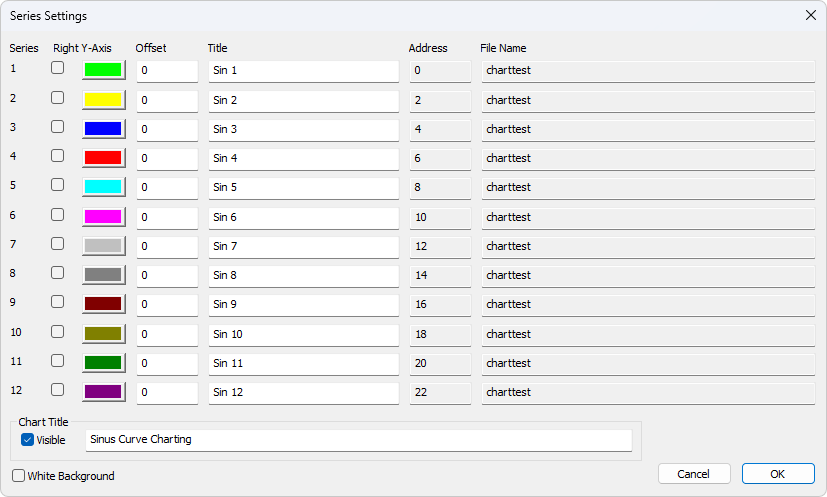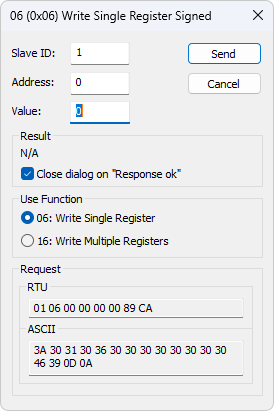


The parameter Always update variables is set to Enabled 1 (use bus cycle task if not used in any task) and is not editable. If your application requires time-consistency for more than 1 word (2 bytes), use the Modbus TCP Slave Device. By contrast, the embedded Modbus TCP server only ensures time-consistency for 1 word (2 bytes). NOTE: The Modbus TCP Slave Device refreshes the %IW and %QW registers as a single time-consistent unit, synchronized with the IEC tasks (MAST task by default). Input means INPUT from Originator controller (= %QW for the controller). NOTE: Output means OUTPUT from Originator controller (= %IW for the controller). The number of words depends on the Holding Registers (%IW) and Input Registers (%QW) parameters of the Modbus TCP tab. The following Modbus commands are supported by the Modbus TCP slave device: The Modbus TCP Slave Device responds to a subset of the Modbus commands with the purpose of exchanging data with the external I/O scanner. This facilitates read/write operations by a Modbus TCP IOScanner application. Once a Modbus TCP Slave Device has been configured, Modbus commands sent to its Unit ID (Modbus address) access the %IW and %QW objects of the controller instead of the regular Modbus words (accessed when the Unit ID is 255). When this same command is sent to the Modbus TCP Slave, it facilitates a read operation by the external I/O scanner. For example, when the Modbus command 3 (3 hex) is sent to a standard Modbus device, it reads and returns the value of one or more registers. Once a Modbus TCP Slave Device has been configured, Modbus commands sent to its Unit ID (Modbus address) are handled differently than the same command would be when addressed to any other Modbus device on the network. O %QWs are mapped from register n to n+m -1 and are read only (m = Input registers quantity, each %QW register is 2 bytes).

O %IWs are mapped from register 0 to n-1 and are R/W (n = Holding register quantity, each %IW register is 2 bytes). The I/Os are mapped to Modbus registers from the master perspective as follows: Number of %QW registers to be used in the exchange (2.120) (each register is 2 bytes) Number of %IW registers to be used in the exchange (2.120) (each register is 2 bytes) Sends the requests to the Modbus TCP slave device (1.247), instead of to the embedded Modbus server (255). NOTE: The port number can be modified using the changeModbusPort script command. NOTE: The watchdog applies to the IP master Address unless the address is 0.0.0.0. The connections are not closed on this address. For more information, refer to the Ethernet Port Read-Only System Variables.įor further information about Modbus TCP, refer to the website. If no Modbus request is received within the timeout duration, the diagnostic information i_byMasterIpLost is set to 1 (TRUE). The watchdog associated to the privileged connection allows you to verify whether the controller is being polled by the privileged master. The Modbus TCP Slave Device can define a privileged Modbus client application, whose connection is not forcefully closed (embedded Modbus connections may be closed when more than 8 connections are needed).

Inputs/outputs are seen from the slave controller: inputs are written by the master, and outputs are read by the master. Once configured, however, the Modbus TCP slave device can be addressed through both Ethernet ports. Only one Modbus TCP Slave Device at a time can be configured on one of the Ethernet ports of the M251 Logic Controller ( Ethernet_1 or Ethernet_2). This Modbus TCP Slave Device functionality allows you to furnish to this area the controller I/O objects which can then be accessed with a single Modbus read/write registers request. This I/O area is used whenever an external master needs to access the %IW and %QW objects of the controller. This functionality creates a specific I/O area in the controller that is accessible with the Modbus TCP protocol. To configure your M251 Logic Controller as a Modbus TCP Slave Device, you must add Modbus TCP Slave Device functionality to your controller (see Adding a Modbus TCP Slave Device thereafter). The embedded Modbus server of the slave controller needs no configuration, and is addressed by specifying a Unit ID equal to 255. This server is addressed by the Modbus client application by specifying a configured Unit ID (Modbus address) in the range 1.247. The Modbus TCP Slave Device adds another Modbus server function to the controller. This section describes the configuration of the M251 Logic Controller as a Modbus TCP Slave Device. Controller as a Slave Device on Modbus TCP


 0 kommentar(er)
0 kommentar(er)
